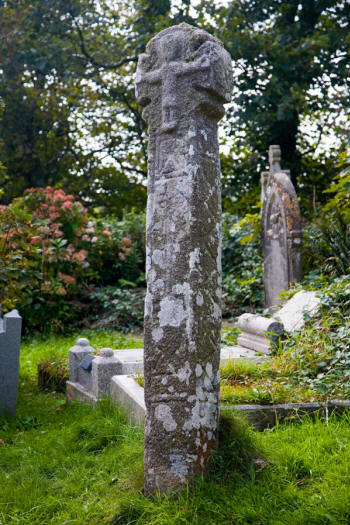|
The Interlace
Ithell Colquhoun
 Some
of Cornwall's old stone crosses are carved with the interlace design
typical of Celtic sculpture and painting: a good example stands in the
churchyard at Sancreed (picture right and below) which, like Paul and
St. Buryan, has several crosses in the vicinity. According to H, O'N
Hencken, the sculptors '.... filled the space with pattern, always one
of the first concerns of the barbaric artist' but in this he shows, like
too many archeologists, an incomprehension of the myth making mind. The
Interlace is no mere pattern, and had we less ignorant eyes we should
discern at once the message conveyed by its different twinings. We
should first have to abandon the idea that literacy is needed for a high
degree of civilisation. According to Hebraic tradition, writing was
taught to humanity by one of the fallen angels: "Man was not
created for such a purpose", as the first Book of Enoch declares. Though
our civilisation (or whatever it is) depends on writing, this is not the
only means of communication. Another means is through the twisting and
knotting of cords in a number of ways, wherein each different coloured
strand modifies the significance. This method has been in use as a
sacred 'language' at various times, literally from China to Peru, in the
latter country the knots being called Quipos. The ribbon-like and
strap-like designs of Celtic manuscripts such as the Book of Kells
and the Lindisfarne Gospels, and the complicated rope-like
reliefs of Celtic sculpture could represent in a decadent state a
version of this language; whether they repeat the sense of the gospels
written words or say something quite different will only be revealed by
deciphering. Possibly they convey the esoteric meaning of a text or
monument. It is noticeable that the Interlace decorates objects which
have (or once had) a numinous value, found chiefly in what we call today
ecclesiastical art. Some
of Cornwall's old stone crosses are carved with the interlace design
typical of Celtic sculpture and painting: a good example stands in the
churchyard at Sancreed (picture right and below) which, like Paul and
St. Buryan, has several crosses in the vicinity. According to H, O'N
Hencken, the sculptors '.... filled the space with pattern, always one
of the first concerns of the barbaric artist' but in this he shows, like
too many archeologists, an incomprehension of the myth making mind. The
Interlace is no mere pattern, and had we less ignorant eyes we should
discern at once the message conveyed by its different twinings. We
should first have to abandon the idea that literacy is needed for a high
degree of civilisation. According to Hebraic tradition, writing was
taught to humanity by one of the fallen angels: "Man was not
created for such a purpose", as the first Book of Enoch declares. Though
our civilisation (or whatever it is) depends on writing, this is not the
only means of communication. Another means is through the twisting and
knotting of cords in a number of ways, wherein each different coloured
strand modifies the significance. This method has been in use as a
sacred 'language' at various times, literally from China to Peru, in the
latter country the knots being called Quipos. The ribbon-like and
strap-like designs of Celtic manuscripts such as the Book of Kells
and the Lindisfarne Gospels, and the complicated rope-like
reliefs of Celtic sculpture could represent in a decadent state a
version of this language; whether they repeat the sense of the gospels
written words or say something quite different will only be revealed by
deciphering. Possibly they convey the esoteric meaning of a text or
monument. It is noticeable that the Interlace decorates objects which
have (or once had) a numinous value, found chiefly in what we call today
ecclesiastical art. In The White
Goddess Robert Graves suggests that the Gordian knot was a means of
conveying a message, therefore Alexander the Great's action in cutting
it through was inappropriate. He destroyed the message
without unravelling it. That we can still use an image taken from
weaving like ‘unravel' to describe the process of elucidation shows that
our thought is not completely dominated by the written word. Since
weaving is based on the crossing of weft and warp, it is an apt ornament
for a cross. - and this, just because it is more than an ornament.
The ‘Cord language‘ may have been brought
over with other Druidic lore by the Ouldcos when they entered the early
Celtic church. In the same way, some of the traditions of ancient Egypt
are preserved in the Coptic church even today, and the Interlace was
first used in Christian art by the Copts.
(first published in
'Quest' 1970)
 |


